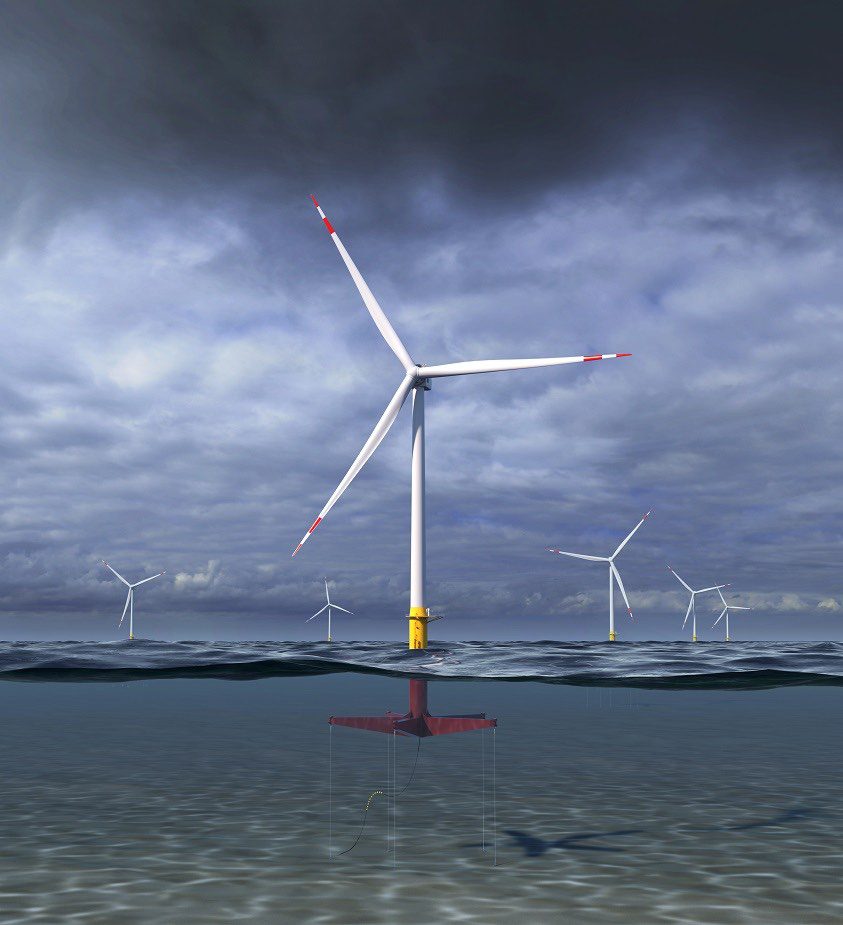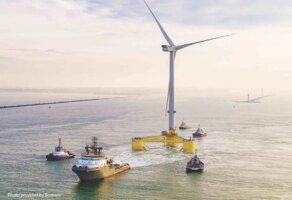Researchers with US energy giant General Electric (GE) have unveiled a 12MW floating wind turbine concept which could dramatically change the face of offshore wind farms, reducing costs while creating access to installation in water depths well beyond currently accessible depths.
Offshore wind farms are, arguably, one of the most attractive long-term renewable energy technologies currently available, particularly for countries short of available land, and it is one of the technologies with the most potential to grow in capacity and generation.
However, current offshore wind farms are reliant upon traditional offshore installation methods which require a signifiant anchor to be built onto the seafloor using expensive building materials and labour.
That creates many challenges, and as water gets deeper (and the winds stronger), the more concrete tat is needed, and the harder and more costly it will be to construct anything.
Enter floating wind turbines.
But, if you remove the need to build concrete seafloor foundations and replace them with floating turbines anchored to the seafloor using lengthy cables, construction costs falls and operating efficiency improves, providing access to stronger and more consistent winds without concern for seafloor depth.
That is why so much research and development is currently focused on floating offshore wind technology, and why the news from GE researchers is so promising.
Announced on Tuesday, GE researchers revealed progress on an ongoing two-year, $US4 million project being run through Aerodynamic Turbines Lighter and Afloat with Nautical Technologies and Integrated Servo-control (ARPA-E’s ATLANTIS) program, and which is aimed at designing and developing advanced controls to support a 12MW floating offshore wind turbine.
Partnering on the project is GE and Glosten, one of the leading design and consulting firms in the marine industry, and the developer of the PelaStar tension-leg platform floating wind turbine foundation.
“Designing a floating turbine is like putting a bus on a tall pole, making it float and then stabilizing it while it interacts with wind and waves,” said Rogier Blom, a senior principal engineer in Model-Based Controls and the project’s principal investigator, who highlighted the sheer size of the problem that requires a floating platform be able to support a structure as tall as 850-feet.
“Doing this well is both a design and controls challenge,” Blom continued. “Through our ATLANTIS project with ARPA-E, we will be concurrently designing the controls system with the design of the floating structure itself to advance Floating Offshore Wind Energy toward becoming a future commercially viable solution.”
GE and Glosten are working together to develop a lighter 12MW GE turbine that can be coupled with Glosten’s tension leg platform technology. This has required designing a lightweight floating turbine with up to 35% less mass in the tower and the floating platform.
By reducing the mass of the tower and floating platform, GE and Glosten hope to create a significant reduction in LCoE generated by a floating turbine.
“With GE’s Haliade-X, the world’s most powerful offshore wind turbine built to date, we’re just beginning to tap into the future promise of offshore wind power in Europe, the US, and other parts of the globe,” Blom said.
“Today, these fixed-bottom wind turbines are limited to depths of 60 meters or less. With floating turbines, we would be able to dramatically expand the reaches of offshore wind power to areas with water depths of 60 meters or greater.”
“We excel when we engage across all of the active disciplines and components as we optimize our floating structures for a full system solution,” said Ben Ackers, Vice President and Principal in Glosten’s Ocean Engineering and Analysis, referencing the collaboration between GE and Glosten.
“Collaborating closely with GE gives us another layer of detailed engineering design input beyond the standard drivers of site conditions, construction cost, schedule, and the resulting LCOE. This is the cooperation needed to bring floating wind to technical and commercial success.”










